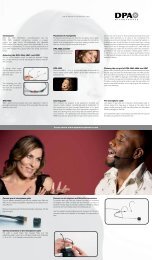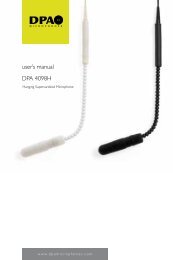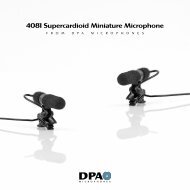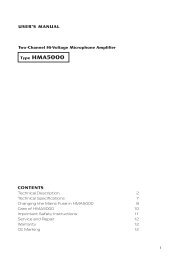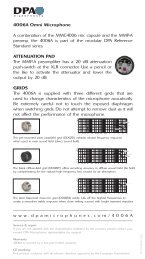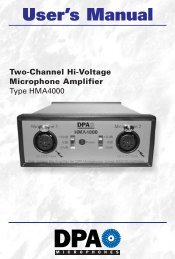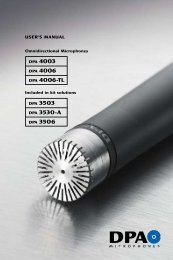The essentials of microphone technology â how ... - DPA Microphones
The essentials of microphone technology â how ... - DPA Microphones
The essentials of microphone technology â how ... - DPA Microphones
Create successful ePaper yourself
Turn your PDF publications into a flip-book with our unique Google optimized e-Paper software.
A cardioid <strong>microphone</strong> can be adjusted to be linear at<br />
the distance it is normally used. A vocal <strong>microphone</strong> for<br />
live use, for example, is adjusted to be linear at a distance<br />
<strong>of</strong> approximately 1 – 2 cm and at longer distances the<br />
low frequencies drop dramatically. A studio <strong>microphone</strong> is<br />
typically adjusted to work at a longer distance.<br />
In the example <strong>of</strong> the <strong>DPA</strong> 401-TL, when used closer<br />
than 30 cm it gives a low frequency boost, and when<br />
used further than 30 cm it gives a low frequency roll<strong>of</strong>f.<br />
That means that from any other distance than 30<br />
cm equalization is needed unless the proximity effect is<br />
desired.<br />
Additionally the <strong>of</strong>f-axis sound <strong>of</strong> a cardioid is less linear<br />
than that <strong>of</strong> an omni. It is very hard to reduce the level<br />
<strong>of</strong> sound taken in from the sides without some coloration,<br />
and some directional <strong>microphone</strong>s have a notably<br />
poor <strong>of</strong>f-axis response.<br />
This means that sound entering the <strong>microphone</strong> from<br />
the sides and the rear are more or less strongly colored<br />
– the industry names this “the curtain effect”. This<br />
effect can be seen on the <strong>microphone</strong>s polar pattern<br />
as ‘spikes’.<br />
On the other hand, miking live with high level monitors<br />
can make the omni mic feed back, which makes the<br />
cardioids more suitable for this application, although the<br />
use <strong>of</strong> in-ear monitors reduces that problem.<br />
Source<br />
Omnidirectional<br />
Cardioid<br />
Bidirectional<br />
Relative distance to sound source for equal balance<br />
between direct and indirect sound.<br />
Multi-pattern <strong>microphone</strong>s with both omnidirectional,<br />
bidirectional and cardioid characteristics will always compromise<br />
the sound quality. It may be very convenient<br />
to have a 3-in-1 solution, but the drawback is reduced<br />
performance in each mode.<br />
Due to the need <strong>of</strong> a pressure gradient design, a multipattern<br />
<strong>microphone</strong> in omni mode has many <strong>of</strong> the<br />
weaknesses <strong>of</strong> the cardioid, such as popping, handling<br />
and wind noise and a less linear <strong>of</strong>f-axis sound. In fact<br />
a multi-pattern <strong>microphone</strong> in the same mode can have<br />
different characteristics depending on the frequency.<br />
Large vs.<br />
small diaphragms<br />
1 1.7 1.9 2<br />
Supercardioid<br />
Hypercardioid<br />
Before choosing between a large and a small diaphragm<br />
<strong>microphone</strong> it is important to know the difference in<br />
features between them, and <strong>microphone</strong> behavior can<br />
not be compared with that <strong>of</strong> a loudspeaker when<br />
considering size.<br />
If you choose an omnidirectional <strong>microphone</strong>, channel<br />
separation may be less precise than with a directional<br />
<strong>microphone</strong>, because the omni will pick up sound from<br />
all directions. <strong>The</strong>refore, if channel separation is preferred,<br />
the ratio between direct and indirect sound can become<br />
more unfavorable with an omni.<br />
<strong>The</strong> omni, <strong>how</strong>ever, can be moved closer to the source,<br />
without the penalty <strong>of</strong> proximity effect. As a general rule<br />
it can be said that if we place a cardioid at a distance<br />
<strong>of</strong> 17 cm to the source, then an omni placed at 10 cm<br />
gives the same ratio <strong>of</strong> direct and indirect sound as the<br />
cardioid.<br />
A large diaphragm <strong>microphone</strong> is not better at reproducing<br />
low-frequencies, but it may be less precise in<br />
reproducing high frequencies, which may make it sound<br />
as if it has more low end.<br />
A small diaphragm has a higher self noise due to the fact<br />
that the small diaphragm is less compliant and therefore<br />
more sensitive to the bombardment <strong>of</strong> air molecules<br />
that causes some <strong>of</strong> the self noise <strong>of</strong> a <strong>microphone</strong>. And<br />
since the large diaphragm is s<strong>of</strong>ter than the small, it is<br />
easier to move and therefore more sensitive – even at<br />
very low levels.<br />
This means that the small diaphragm, because it’s stiff,<br />
can handle a higher sound pressure without clipping or<br />
distortion, but is less sensitive and needs more amplification,<br />
which also adds a little noise.<br />
<strong>The</strong> <strong>essentials</strong> <strong>of</strong> <strong>microphone</strong> <strong>technology</strong>: How to choose the right mic for the job





